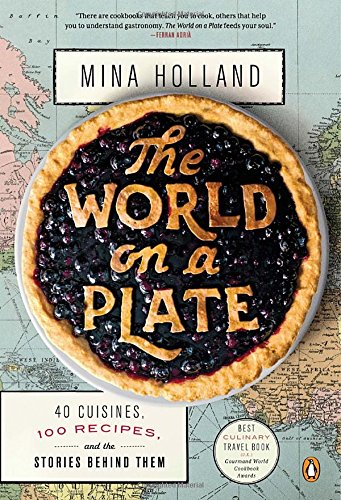
The World on a Plate
40 Cuisines, 100 Recipes, and the Stories Behind Them
کتاب های مرتبط
- اطلاعات
- نقد و بررسی
- دیدگاه کاربران
نقد و بررسی

April 6, 2015
Holland, the British editor of Guardian Cook, draws from a dizzyingly broad sweep of world cooking for this discussion of terroir, ingredients, methods, and spices. The idea of her book, she says earnestly, is for readers to be able to sample global cuisines in their homes. Each section includes history and geography lessons as well as culinary information; the section on South Korea, for example, offers a small sample map, an introduction to Korean cooking in four pages (“Korean food makes you work hard”), a pantry list including daikon and jeotgal (a fermented condiment), and recipes for beef bulgogi and the national pickled dish of kimchi. Such European countries as France, Spain, and Italy earn breakdowns by region (e.g., Loire Valley, Andalucia), while Scandinavia gets a general grouping (praised for “Viking pragmatism”), and the Middle East is summarized by some shared ingredients among Turkey, Israel, and Iran (Holland emphasizes the extent and influence of Persian cooking). The author traces the South American chili pepper across the cuisines of Africa and India for a sampling of transformative
recipes—Kashmiri rogan josh, Ethiopian chickpea stew—as well as a spice route. She admits she has never visited West Africa and has gleaned those recipes from notable experts, authors, and chefs. This is a tightly scripted encyclopedic experience, not an original or hands-on cookbook.

April 1, 2015
In her first book, Guardian Cook editor Holland salutes classic dishes from a few dozen different countries. Much more than a cookbook, this hybrid narrative combines recipes, pantry lists, kitchen essentials, literary references, history, geography, and personal reflections on 40 culinary traditions around the globe. Holland hopes to stimulate readers' sensory curiosity and enliven their taste buds, and her book serves as a starting point for learning about the ingredients, flavors, and highlights of various cuisines, in addition to common recipes from each country or region-e.g., tapenade from Provence, cottage pie from the U.K., kimchi from Korea, tabbouleh from the Levant, and dulce de leche from Argentina. The author focuses on cuisines from a range of regions throughout the world-Europe, the Middle East, Asia, Africa, and the Americas-and she demystifies common food-prep strategies and pantry lists. For example, if you are considering an Ethiopian dinner, you should stock up on chickpeas, peanuts, and red lentils. If you're thinking of serving guests an Iranian meal, you will need rose water, saffron, yogurt, dried limes, cumin, and kidney beans. Holland introduces each country or region with an essay explaining how culture, history, and politics have combined to make each place and its foods unique. Weaving in her personal "culinary interests and experiences" from her travels and encounters with "talented chefs, food experts and writers, from whom I've taken inspiration and practical tips in equal measure," the author delivers consistently absorbing reading. Throughout, literary references abound. Holland begins each section with a quote from a writer identified in some way with the country, adding another layer of interest to the narrative. For those hungry for more tidbits, Holland includes helpful footnotes and a reading list for additional exploration. A culinary adventure that delights on many levels and leaves readers hungering for more.

April 15, 2015
Holland (acting editor, Guardian Cook) delves into the history, politics, mood, and culture of 40 countries' cuisines, adapting 100 recipes from friends, family, cookbooks, and professional foodies. Narratives open each section (Europe, the Middle East, Asia, Africa, the Americas), with discussion and insights on specific foods within the five regions. The writing is infused with literary references--quotes from cookbook authors, travel writers, and novelists and stories from Holland's own extensive travels. The recipes assume familiarity with cooking (instructions don't remind readers to peel beets or wash leeks, for example) and may call for ingredients not carried by typical grocery stores in the United States. Most of the essays and recipes have a global yet deeply personal touch, and Holland's evocative language ("hunks of butter"; "fizzy, fermented kimchi") engages readers' senses. The two or three recipes for each geographic area give samplings of style, or signature dishes, but do not combine to make a meal. A helpful further reading list will guide interested cooks to in-depth titles on each cuisine. VERDICT Holland's explanations of why and how ingredients, preparation styles, and flavors developed around the world will appeal to armchair gastronomes.--Maggie Knapp, Trinity Valley Sch., Fort Worth, TX
Copyright 2015 Library Journal, LLC Used with permission.

April 1, 2015
Food has the evocative power to recall vivid memories of tastes and smellsand geographydeclares food and travel writer Holland. From her travels, she offers 40 world cuisines, the edible lovechild of both geography and history. Holland notes the benchmark set by French cuisine, with so many towns and regions lending their names to excellent food and wine from Dijon to Camembert to Cognac. She takes into account how cuisines have evolved from invasions and immigrations, amalgamating the cuisines of various cultures as they collided, merged, and finally settled into something distinct. The book is divided according to world regionsEurope, the Middle East, Asia, Africa, and the Americas. Among the recipes are apple tart Normande from France, Catalan fish stew and zucchini cream from Spain, fattoush and chelow rice from the Middle East, rogan josh and coconut fish curry from India, gomen stew from Ethiopia, chicken couscous from Morocco, buttermilk cornbread from Louisiana, fruity one-chili mole from Mexico, and ceviche from Peru. Holland invites readers to treat this book as a passport to visit locales through the most authentic insight into culture offered by everyday dishes.(Reprinted with permission of Booklist, copyright 2015, American Library Association.)

























دیدگاه کاربران